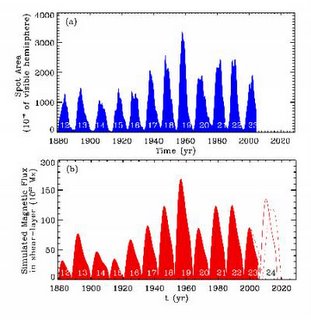
Scientists issue unprecedented forecast of next sunspot cycle
The next sunspot cycle will be 30-50% stronger than the last one and begin as much as a year late, according to a breakthrough forecast using a computer model of solar dynamics developed by scientists at the National Center for Atmospheric Research (NCAR). Predicting the Sun's cycles accurately, years in advance, will help societies plan for active bouts of solar storms, which can slow satellite orbits, disrupt communications, and bring down power systems.
The scientists have confidence in the forecast because, in a series of test runs, the newly developed model simulated the strength of the past eight solar cycles with more than 98% accuracy. The forecasts are generated, in part, by tracking the subsurface movements of the sunspot remnants of the previous two solar cycles. The team is publishing its forecast in the current issue of Geophysical research letters.
"Our model has demonstrated the necessary skill to be used as a forecasting tool," says NCAR scientist Mausumi Dikpati, the leader of the forecast team at NCAR's High Altitude observatory.
The Sun goes through approximately 11-year cycles, from peak storm activity to quiet and back again. Solar scientists have tracked them for some time without being able to predict their relative intensity or timing.
As I have previously commentated on with the Russian hypothesis on solar effects and climate we may be going to get a little cold....
Scientists from the Central Aerological Observatory of the RF hydrometeorological organization Roshydromet and the Lebedev Physics Institute have voiced their views on the subject.They believe that cosmic rays play a large role in this process and they offer a physical explanation for this effect.
A flow of cosmic rays constantly falls onto the upper limit of the atmosphere. Under interaction with the atmosphere it gives rise to secondary radiation. A maximal flow of secondary cosmic rays is observed in the stratosphere at altitudes of 15-20km and it is affected by solar activity. Cosmic rays ionize air in the stratosphere and the troposphere, which explains the electrical conductivity of air at these altitudes and the electrical activity of storm clouds. The electrical field created by the Earth’s charge accelerates adherence of light ions to uncharged aerosol particles, and charged aerosol particles become the centres of water vapour condensation, on which cloud droplets arise, far more easily than uncharged particles. This leads to an increase in nebulosity in the lower part of the troposphere, which influences the flow of solar energy and, accordingly, the temperature of the near-Earth
atmosphere.
A reduction in the flow of cosmic rays, observed in the 20th Century, is accompanied by a fall in the speed of ionisation and electrical conductivity of air in the stratosphere and the troposphere, a drop in the storm activity and voltage of the Earth’s electrical field and a reduction of low cloud cover, meaning a rise in the temperature of the near-Earth layer of air.A jump is expected in the 200-year cycle of the flow of cosmic rays in the 21st Century and the authors of the hypothesis believe there will be not a further warming of the climate but quite the opposite – climate cooling.

0 Comments:
Post a Comment
<< Home